List of Contents
What is the Immunoprotein Diagnostic Testing Market Size?
The global immunoprotein diagnostic testing market size is accounted at USD 10.32 billion in 2025 and is predicted to increase from USD 11.12 billion in 2026 to approximately USD 20.19 billion by 2034, expanding at a CAGR of 7.74% from 2025 to 2034. The market is expanding rapidly due to the rising prevalence of chronic and infectious diseases and technological advancements like ELISA. The rising demand for personalized medicine and improvements in healthcare infrastructure further support market growth.
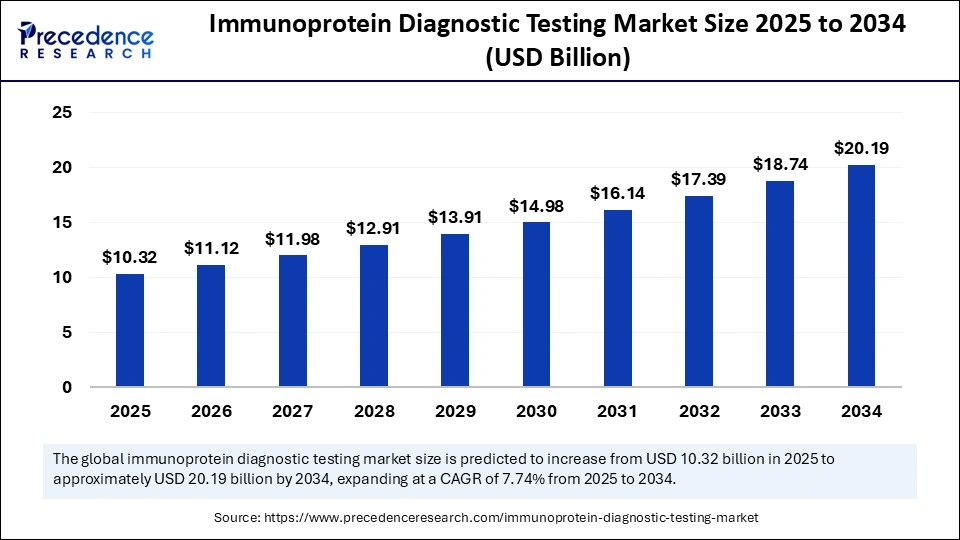
Immunoprotein Diagnostic Testing MarketKey Takeaways
- North America dominated the global market with the largest share of 45% in 2024.
- Asia Pacific is expected to grow at the fastest CAGR 8.74% during the forecast period.
- By test, the immunoglobulin diagnostic tests segment captured the biggest market share of 28% in 2024.
- By test, the C-reactive protein (CRP) diagnostic tests segment is expected to expand at the fastest CAGR 8.34% in the coming years.
- By application, the infectious disease testing segment contributed the highest market share of 25% in 2024.
- By application, the oncology testing segment is expected to grow at the fastest CAGR of 8.15% during the predicted timeframe.
- By technology, the enzyme-based immunoassay segment held the major share of 26% in 2024.
- By technology, the chemiluminescence assay segment is expected to grow at the fastest CAGR of 9.34% during the period.
- By distribution channel, the retail sales segment accounted for the biggest market share of 54%in 2024.
- By distribution channel, the direct tender segment is anticipated to grow at the fastest CAGR 8.14% during the projection period.
- By end-user, the hospitals and clinics segment generated the major market share of 45% in 2024.
- By end-user, the diagnostic laboratories segment is expected to grow at the fastest CAGR of 8.54% in the upcoming years.
Strategic Overview of the Global Immunoprotein Diagnostic Testing Industry
The immunoprotein diagnostic testing market pertains to analyzing and identifying protein levels in the body to diagnose and monitor diseases related to specific proteins, such as immunoglobulin, pre-albumin, and others. The market is experiencing significant growth due to the increasing prevalence of infectious and chronic diseases, along with advancements in diagnostic technologies and a rising awareness of early disease detection. The rising number of conditions like autoimmune disorders, cancer, cardiovascular diseases, and infections are expected to boost the growth of the market, as immunoprotein tests are crucial for diagnosing these conditions.
Artificial Intelligence: The Next Growth Catalyst in Immunoprotein Diagnostic Testing
Artificial Intelligence is transforming the immunoprotein diagnostic testing market by enhancing accuracy, speeding up diagnosis, and enabling personalized medicine. AI algorithms can analyze intricate datasets to identify patterns and anomalies, leading to earlier and more accurate disease detection. AI-powered systems can also detect early signs of disease, allowing for timely intervention and improved patient outcomes. AI algorithms analyze vast datasets of immunoprotein test results, leading to more accurate diagnoses and reducing the chances of false positives and negatives.
Market Outlook
- Market Growth Overview: The immunoprotein diagnostic testing market is expected to grow significantly between 2025 and 2034, driven by advancements in immunoassay technologies, increasing global prevalence of chronic diseases, and preventive healthcare awareness.
- Sustainability Trends: Sustainability trends involve eco-friendly materials and consumables, energy efficiency in manufacturing and operations, and circular economy practices and waste reduction.
- Major Investors: Major investors in the market include Thermo Fisher Scientific Inc., Danaher Corporation, F. Hoffmann-La Roche Ltd., Abbott Laboratories and Siemens Healthineers AG.
Startup Economy: The startup economy is focused on AI and machine learning, microfluidics and point-of-care, and addressing niche testing areas.
Immunoprotein Diagnostic Testing MarketGrowth Factors
- Increased Awareness of Early Disease Detection: Increased public awareness about healthcare and the importance of early disease detection, along with the availability of accurate diagnostic tools, fuels the market.
- Investment in Research and Development: Government and private initiatives supporting research and development of new technologies and devices due to their ability to provide reliable outcomes with better sensitivity and specificity, further stimulate market expansion.
- Increasing Demand for Rapid and Accurate Diagnostics: The demand for rapid and accurate tools to facilitate effective disease management and therapeutic decision-making drives the growth of the market.
- Technological Advancements: Innovations in diagnostic technologies, such as ELISA and Chemiluminescence assay, enhance the accuracy and efficiency of testing, reduce turnaround times, and improve accessibility, particularly in isolated and underdeveloped areas, contributing to market growth.
Market Scope
| Report Coverage | Details |
| Market Size by 2034 | USD 20.19 Billion |
| Market Size in 2026 | USD 11.12 Billion |
| Market Size in 2025 | USD 10.32 Billion |
| Market Growth Rate from 2025 to 2034 | CAGR of 7.74% |
| Dominating Region | North America |
| Fastest Growing Region | Asia Pacific |
| Base Year | 2024 |
| Forecast Period | 2025 to 2034 |
| Segments Covered | Test, Application, Technology, Distribution Channel, End-User, and Region |
| Regions Covered | North America, Europe, Asia-Pacific, Latin America, and Middle East & Africa |
Market Dynamics
Drivers
Increasing Prevalence of Infectious and Chronic Diseases
The rising prevalence of infectious and chronic diseases across the globe is a major factor driving the growth of the immunoprotein diagnostic testing market. Chronic diseases like cancer and autoimmune disorders require immunoprotein diagnostics testing to diagnose and monitor conditions. This testing provides crucial insights into the underlying mechanism of these diseases, which helps in making informed decisions regarding treatments. In addition, the rising awareness among people about the early detection of diseases is boosting the demand for accurate and rapid diagnostics, further propelling the market growth.
Restraint
High Cost of Diagnostic Tests and Limited Reimbursement Policies
A major restraint in the immunoprotein diagnostic testing market is the high cost of immunoprotein diagnostic tests. High costs can make these tests less accessible to patients, restraining market growth. Limited reimbursement policies for diagnostic tests, especially in low and middle-income countries, impact the accessibility of these tests. In addition to this, the availability of alternative tests creates challenges in the market.
- In May 2022, Labcorp launched an at-home collection kit through Labcorp OnDemand that measures hemoglobin A1c (HbA1c) from a small blood sample. This makes screening for conditions like diabetes more convenient and accessible, addressing some reimbursement issues as it can be self-administered.
Opportunity
Development and Adoption of Multiplex Testing and Point-of-Care Testing
The key future opportunity in the immunoprotein diagnostic testing market resides in the development and adoption of multiplex testing and point-of-care testing. This involves detecting multiple biomarkers simultaneously in a single test, saving time and resources. The growing demand for comprehensive diagnostics and screening creates the need for multiplex testing. The increasing demand for home care and telehealth is propelling the demand for home-based, point-of-care testing. In addition, advancements in proteomics and genomics open up new opportunities for the development of comprehensive immunoprotein diagnostic testing kits.
Segment Insight
Test Insights
Why did Immunoglobulin Diagnostic Tests Segment Dominate the Market in 2024?
The immunoglobulin diagnostic tests segment dominated the immunoprotein diagnostic testing market with the largest share in 2024 due to their broad diagnostic applications, including identifying immune deficiencies, autoimmune disorders, and infectious diseases. These tests measure immunoglobulin levels such as IgG, IgM, IgA, and IgE, which help to identify deficiencies that compromise the ability of the immune system to fight infections and assess immune system functions, thus guiding the diagnosis and monitoring of various conditions. Additionally, these tests are used to assess antibody responses to vaccines and ensure their effectiveness and, therefore, are widely adopted in clinical practice.
The C-reactive protein (CRP) diagnostic tests segment is expected to expand at the fastest rate in the coming years due to the increasing prevalence of chronic and inflammatory diseases, advancements in diagnostic techniques, and the shift toward early disease detection, along with a growing emphasis on preventive healthcare and antibiotic stewardship. CRP, as a marker for inflammation, is widely used to assess a range of conditions, from infections to autoimmune disorders, and its sensitivity and specificity make it a valuable tool for diagnosis and monitoring.
Application Insights
How does the Infectious Disease Testing Segment Dominate the Immunoprotein Diagnostic Testing Market?
The infectious disease testing segment dominated the market with the largest share in 2024. Infectious diseases like AIDS, tuberculosis, hepatitis, and sexually transmitted infections require accurate and timely diagnosis for effective treatment and control. The increased demand for early and accurate diagnosis and the critical role immunoprotein diagnostic tests play in managing public health bolstered segmental growth. Advancements like multiplexed PCR assays, particularly for respiratory viruses like RSV, along with advances in point-of-care testing, further ensure the long-term growth of the segment.
The oncology testing segment is expected to grow at the fastest rate during the predicted timeframe. This is mainly due to the rising global burden of cancer and the rapid shift toward earlier cancer detection and personalized treatment plans. Advancements in diagnostic technologies like liquid biopsies and next-generation sequencing improve the speed, accuracy, and sensitivity of infectious disease testing. Furthermore, the increasing use of AI in oncology for early cancer detection contributes to segmental growth.
Technology Insights
What Made Enzyme-based Immunoassay the Dominant Segment in the Market?
The enzyme-based immunoassays segment dominated the immunoprotein diagnostic testing market with a major share in 2024 due to its high sensitivity, specificity, and ease of automation, making them ideal for detecting and quantifying various biomarkers in biological samples, including blood, serum, and urine. The segment's dominance is reinforced by the increased demand for diagnostic services and ostensibly rising chronic and infectious disease prevalence. Enzyme immunoassays can detect low levels of antigens and antibodies with high accuracy, making them suitable for early disease detection and monitoring.
The chemiluminescence assay segment is observed to be the fastest-growing segment during the forecast period. Chemiluminescence assays provide strong and detectable signals, allowing for meticulous measurements even with small sample volumes, which is crucial for detecting biomarkers at low concentrations. Moreover, their high sensitivity and ability to detect a wide range of biomarkers lead to faster and more efficient testing, which further enhances their capabilities and market appeal.
Distribution Channel Insights
Why did the Retail Sales Segment Dominate the Market in 2024?
The retail sales segment dominated the immunoprotein diagnostic testing market with the highest share in 2024 due to the increased accessibility and convenience for patients. Retail outlets, comprising pharmacies and health stores, provide easy access to diagnostic tests, making these tests easily available and empowering individuals to proactively manage their health with readily accessible testing options. This convenience contributes to higher adoption and greater public awareness about the importance of diagnostic testing, further pushing segmental growth.
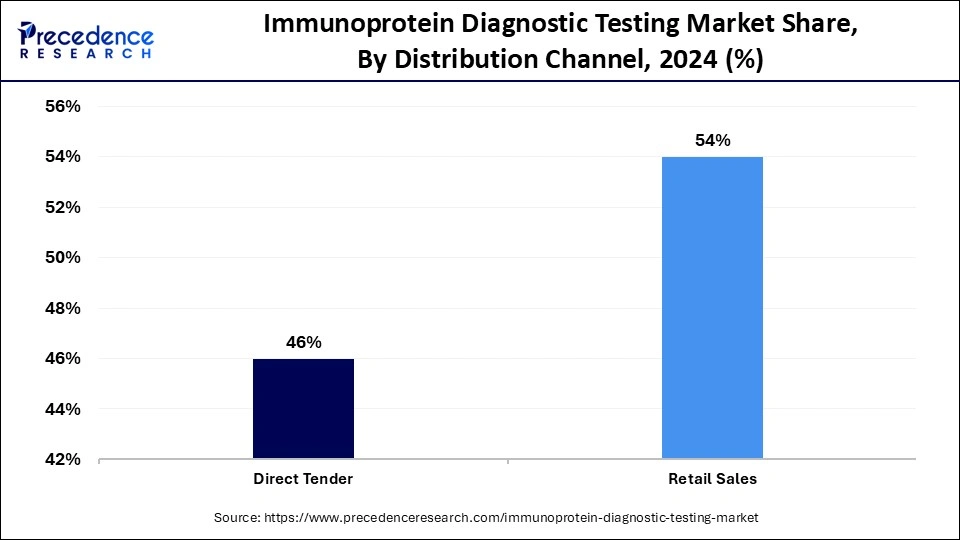
The direct tender segment is anticipated to grow at the fastest rate during the projection period due to its efficient and cost-effective procurement process for large-scale healthcare facilities. This approach empowers healthcare facilities to secure large quantities of diagnostic tests at negotiated prices, potentially saving significant costs. Recent advancements, such as developments in chemiluminescence immunoassay, enzyme-linked immunosorbent assay, and multiplex immunoassay systems, have ameliorated disease detection and workflow efficiency in hospitals and diagnostic laboratories. Direct tender enables hospitals and laboratories to purchase diagnostic kits in bulk, improving the accessibility to patients.
End-User Insights
What Made Hospitals and Clinics the Dominant Segment in the Market?
The hospitals and clinics segment dominated the immunoprotein diagnostic testing market with the biggest share in 2024. This is mainly due to their high patient volume and the requirement for rapid, precise, and comprehensive diagnostic testing. These facilities have adequate infrastructure, equipment, and specialized personnel to perform a wide range of immunoprotein tests, often serving as the primary point of contact for patients requiring such diagnostics.
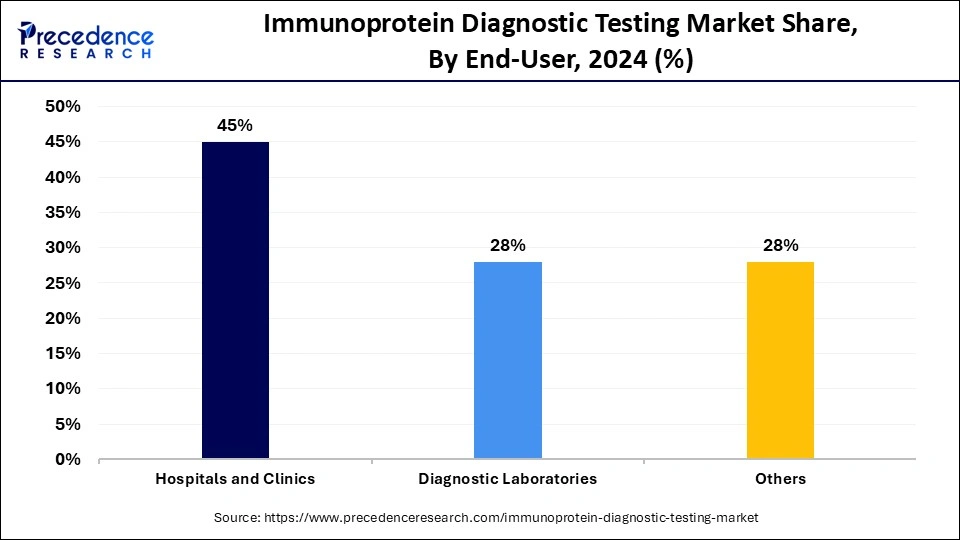
The diagnostic laboratories segment is expected to grow at the fastest CAGR in the upcoming years because of the increasing burden of chronic and infectious diseases, advancements in technology, and the need for standardized, reliable testing. Also, these laboratories offer centralized testing with standardized procedures and quality control, ensuring more consistent and reliable results, which is crucial for accurate diagnosis and treatment. These settings provide comprehensive testing, enabling patients to perform diagnoses. The focus on POC care devices and collaborations between diagnostic and pharmaceutical companies support segmental growth.
Regional Insights
U.S. Immunoprotein Diagnostic Testing Market Size and Growth 2025 to 2034
The U.S. immunoprotein diagnostic testing market size is exhibited at USD 3.95 billion in 2025 and is projected to be worth around USD 7.85 billion by 2034, growing at a CAGR of 7.93% from 2025 to 2034.
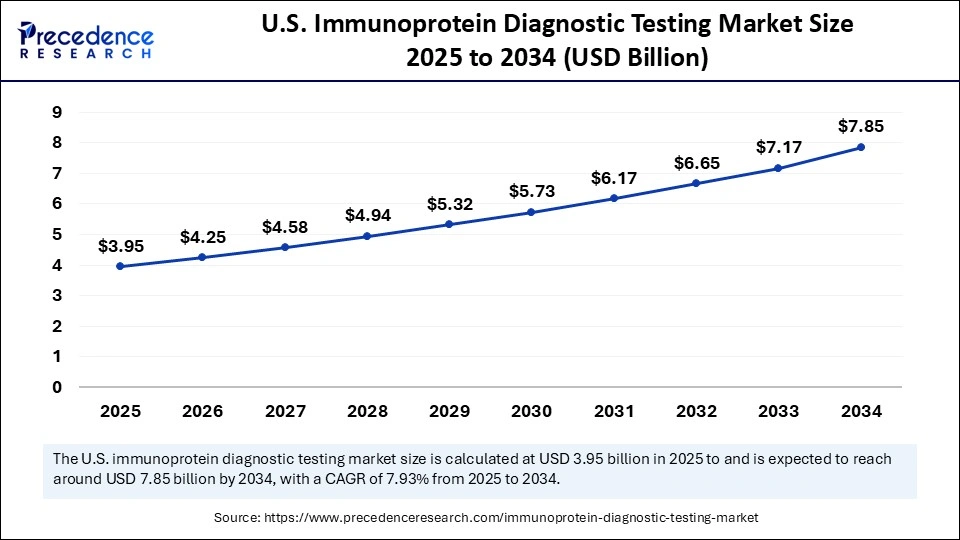
What Factors Contribute to North America's Dominance?
North America dominated the immunoprotein diagnostic testing market by holding the largest share in 2024 due to a combination of factors, including technological advancements, a robust healthcare infrastructure, and the high prevalence of chronic diseases. As the region is at the forefront of developing and adopting innovative diagnostic technologies, including immunoprotein testing methods and well-established healthcare infrastructure, strong regulatory frameworks and skilled healthcare professionals contribute to easy access to diagnostic testing. Recent government initiatives, such as the Regulatory Amendments of Canada and collaborations, further solidify this dominance, coupled with the increasing incidence of chronic diseases like cancer, heart disease, and diabetes, driving the demand for effective diagnostic testing.
U.S. Immunoprotein Diagnostic Testing Trends
The U.S. is a major player in the market within North America due to its robust healthcare infrastructure, high cancer incidence rates, and the presence of major industry players such as Abbott Laboratories, Roche Diagnostics, and Siemens. The U.S. has a well-established infrastructure with advanced diagnostic facilities, skilled professionals, and a strong regulatory framework, facilitating access to diagnostic testing. Furthermore, the prevalence of chronic diseases and cancer, coupled with increased research and development investments, drives the demand for these tests.
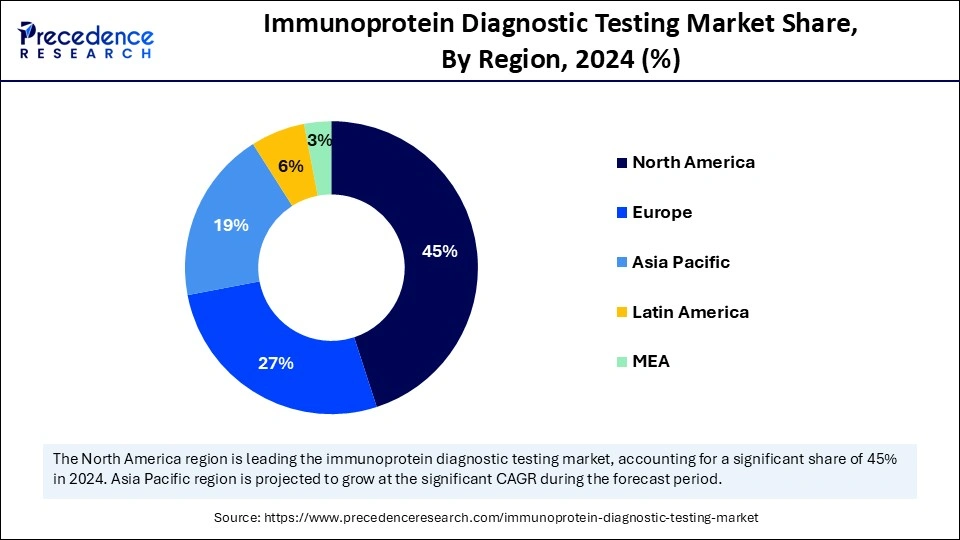
Asia Pacific Immunoprotein Diagnostic Testing Market Trends
Asia Pacific is expected to grow at the fastest rate in the market during the forecast period, driven by the rising prevalence of chronic and infectious diseases, a growing aging population, increasing healthcare spending, and government initiatives promoting disease prevention and early detection. The region faces a significant burden of chronic diseases like diabetes, cardiovascular diseases, and infectious diseases, increasing the need for accurate and timely diagnostics. The 2023 Nipah virus outbreak in India, for example, highlighted the demand for rapid diagnostic testing. Government support and collaborations between research institutions and healthcare organizations are also fostering innovation and driving market growth.
India Immunoprotein Diagnostic Testing Market Trends
India is emerging as a major player in the immunoprotein diagnostic testing market within Asia Pacific due to its large population, coupled with a rising number of individuals with chronic and infectious diseases, which fuels the need for immunoprotein diagnostic services. India is prioritizing healthcare infrastructure development and advancements in diagnosis methods, further contributing to the growth of the immunoprotein diagnostic testing market. Moreover, a growing geriatric population and increasing awareness of early disease detection are also driving the demand for immunoprotein diagnostic tests, particularly for conditions like diabetes and cancer.
- In January 2025, Pradhan Mantri Ayushman Bharat Health Infrastructure Mission (PM-ABHIM) focuses on strengthening primary, secondary, and tertiary healthcare infrastructure, integrating digital health technologies to improve service delivery. This initiative aims to develop robust public health laboratories, bolster emergency response capacities, and enhance medical research through digital databases.
China Immunoprotein Diagnostic Testing Market Trends
China plays an important role in the market because of its rising healthcare infrastructure, including laboratories and clinics, which ensures wider access to diagnostic services. The government initiatives are investing heavily in healthcare infrastructure and promoting early disease detection, boosting the demand for immunoprotein diagnostic tests. The focus of China on addressing the high prevalence of infectious diseases, such as HIV, cancer, and other infectious diseases, is driving the demand for immunoprotein diagnostic tests, along with product innovation and local production of diagnostic tools, reducing reliance on imported kits and devices.
European Immunoprotein Diagnostic Testing Market Trends
Europe is expected to grow at a notable rate due to a high prevalence of chronic diseases, a strong emphasis on early disease detection, and a growing geriatric population. Technological advancements, including enzyme-based immunoassays and chemiluminescence assays, are improving the accuracy and speed of test results, contributing to enhanced adoption in clinical settings. A strong focus on personalized medicine and government initiatives further contribute to regional market growth.
Germany Immunoprotein Diagnostic Testing Trends
Germany's strong adoption of fully automated immunoassay analyzers and high-throughput systems reduces testing turnaround times and enhances laboratory efficiency. Integration of AI and digital health, high prevalence of chronic diseases, and a shift towards point-of-care and shift testing.
Immunoprotein Diagnostic Testing Market Value Chain Analysis
Research and Development (R&D) & Assay Design
This foundational stage involves discovering new biomarkers and developing sensitive and specific immunoassay designs (e.g., ELISA, CLIA, lateral flow) for detecting various diseases like cancer, autoimmune disorders, and infectious diseases.
- Key Players: F. Hoffmann-La Roche Ltd., Siemens Healthineers AG, Abbott Laboratories, Thermo Fisher Scientific Inc. (including The Binding Site Group), Bio-Rad Laboratories, Inc.
Raw Material & Component Sourcing
This stage involves the procurement of high-purity biological raw materials such as antigens, antibodies, enzymes, and chemical reagents, as well as electronic components for diagnostic instruments and plastic consumables like microplates and test strips.
- Key Players: Merck KGaA (Sigma-Aldrich), Bio-Rad Laboratories, Inc., various fine chemical suppliers, specialized biosensor and plastic component manufacturers.
Manufacturing and Assembly
In this stage, raw materials are converted into finished diagnostic instruments (analyzers) and the associated single-use consumables (reagent kits, cartridges, tests) through precision manufacturing processes.
- Key Players: F. Hoffmann-La Roche Ltd., Siemens Healthineers AG, Abbott Laboratories, Danaher Corporation (through subsidiaries like Beckman Coulter), QuidelOrtho Corporation.
Distribution and Sales
The finished diagnostic products are distributed globally to a wide range of customers, including central clinical laboratories, hospitals, clinics (for point-of-care), and research institutions via direct sales forces and a network of specialized distributors.
- Key Players: McKesson Corporation, Cardinal Health, Inc., AmerisourceBergen Corporation, regional distributors, and manufacturers' direct sales teams.
Top Companies in the Immunoprotein Diagnostic Testing Market & Their Offerings
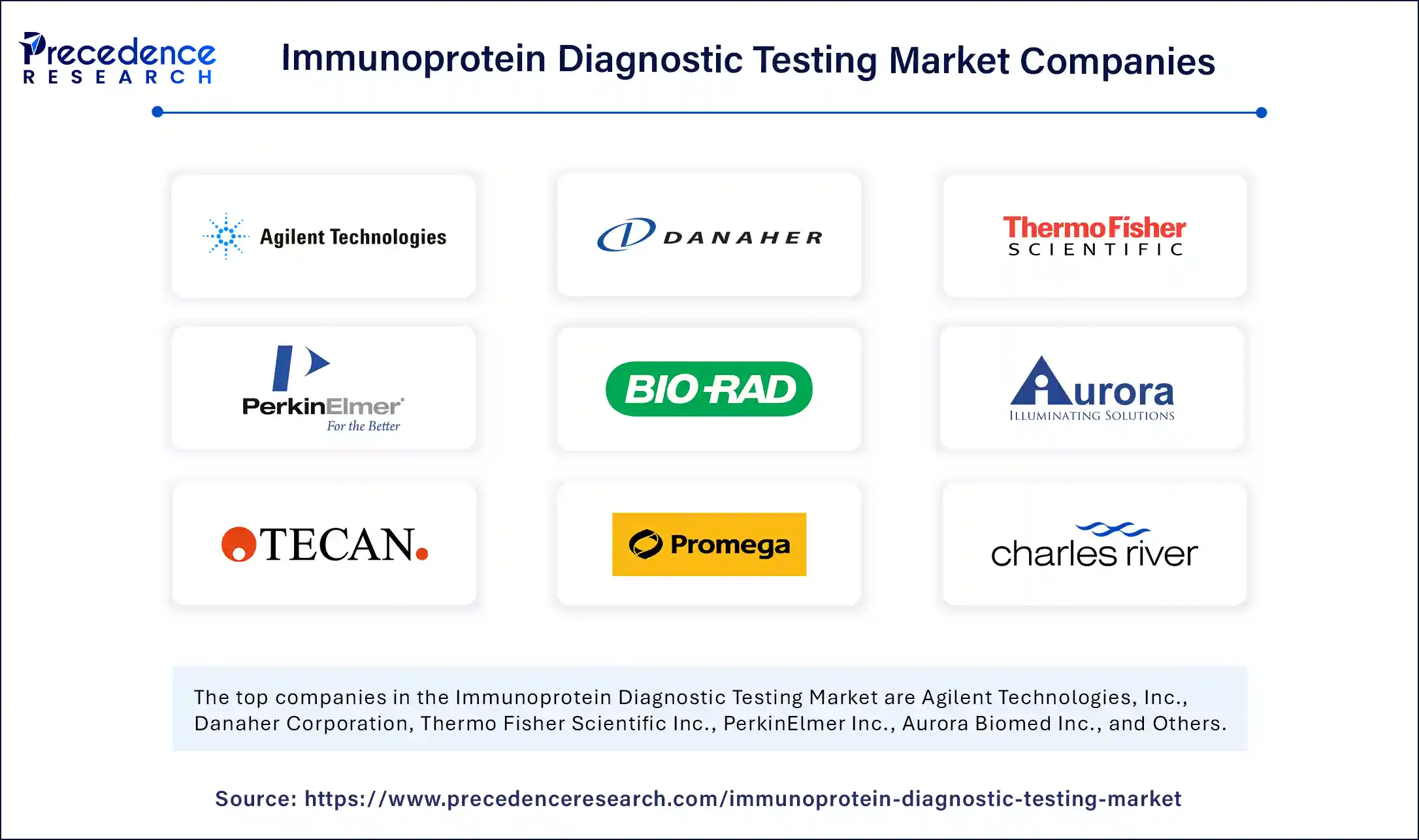
- Agilent Technologies, Inc.: Agilent provides analytical instrumentation, software, and consumables that are essential for the research and development phase of immunoprotein diagnostic tests.
- Danaher Corporation: Danaher contributes significantly to the market through its life sciences and diagnostics subsidiaries (e.g., Beckman Coulter, Leica Biosystems), which provide a wide range of immunoassay analyzers, reagents, and automation solutions for clinical laboratories.
- Thermo Fisher Scientific Inc.:A global leader, Thermo Fisher provides an extensive portfolio of immunodiagnostic instruments, reagents, and consumables, and recently expanded its offering in immunoproteins with the acquisition of The Binding Site Group.
- PerkinElmer Inc.: PerkinElmer provides detection and imaging technologies, software, and consumables that enable R&D and clinical application of immunoprotein diagnostics, especially in high-throughput screening and specialized testing.
- Bio-Rad Laboratories, Inc.: Bio-Rad is a key supplier of life science research and clinical diagnostics products, including a variety of immunoprotein assays, quality control systems, and instruments for disease monitoring and diagnosis.
- Aurora Biomed Inc.: Aurora Biomed focuses on laboratory automation and liquid handling robotics, providing efficient systems that streamline the manual processes in immunoprotein diagnostic testing labs.
- Tecan Trading AG:Tecan provides laboratory instruments and automation solutions, including plate readers and liquid handling systems, that are crucial for the efficient and accurate execution of immunoprotein diagnostic assays like ELISA.
- Promega Corporation: Promega develops and manufactures a range of reagents, enzymes, and assays used in immunoprotein R&D and manufacturing, contributing essential components that underpin diagnostic test development.
- Charles River Laboratories:Charles River supports the pharmaceutical and biotech industry with preclinical and clinical laboratory services, contributing to the safety and efficacy testing of novel immunoprotein diagnostic products.
- Creative Biolabs:This company offers custom research and manufacturing services for the development of antibodies and other biologicals, contributing essential raw materials and R&D support to companies developing immunoprotein diagnostic tests.
Recent Developments
- In April 2025, Virax Biolabs Group Limited, an innovative biotechnology company focused on the detection of immune responses and diagnosis of viral diseases, launched ImmuneSelect within the ViraxImmune T-Cell diagnostic platform for research-use-only, at the European Society of Clinical Microbiology and Infectious Diseases Global 2024 (ESCMID) Congress.
- In July 2023, Atellica CI Analyzer, the newest addition to the Siemens Healthineers Atellica in vitro diagnostics portfolio for immunoassay and clinical chemistry testing, received FDA clearance and is now available in many of the major markets of the world.
Segments Covered in the Report
By Test
- Complement System Proteins Diagnostic Tests
- Free Light Chain Diagnostic Tests
- Haptoglobin Diagnostic Tests
- Immunoglobulin Diagnostic Tests
- Prealbumin Diagnostic Tests
- C-Reactive Protein (CRP) Diagnostic Tests
By Application
- Infectious Disease Testing
- Oncology Testing
- Endocrine Testing
- Toxicology Testing
- Allergy Testing
- Autoimmune Disease Testing
By Technology
- Radioimmunoassay
- Enzyme-Based Immunoassay
- Chemiluminescence Assay
- Immunofluorescence Assay
- Immunoturbidity Assay
- Immunoprotein Electrophoresis
By Distribution Channel
- Direct Tender
- Retail Sales
By End-User
- Hospitals and Clinics
- Diagnostic Laboratories
- Others
By Region
- North America
- Europe
- Asia-Pacific
- Latin America
- Middle East and Africa
For inquiries regarding discounts, bulk purchases, or customization requests, please contact us at sales@precedenceresearch.com
Frequently Asked Questions
Ask For Sample
No cookie-cutter, only authentic analysis – take the 1st step to become a Precedence Research client